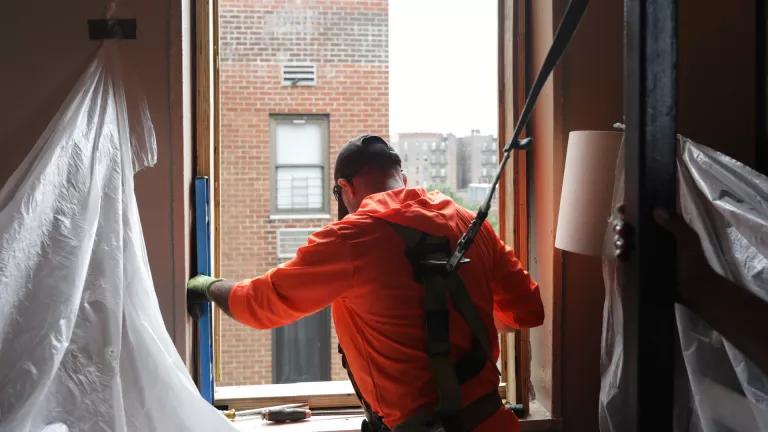It's Time for Pennsylvania to Act on Environmental Justice
The state's DEP should finalize the EJ policy—making revisions in accordance with the equity groups’ recommendations—and put it to work on RGGI investments.

The Pennsylvania Department of Environmental Protection has an open public comment period on proposed revisions to the DEP’s Environmental Justice Policy guidance (EJ Policy). The deadline for written comments is May 11 and the last of four public hearings is May 4 at 6:00 pm.
This blog: (1) summarizes the EJ Policy; (2) outlines recommendations that a group of Pennsylvania frontline community, community-based, and low-income advocacy groups have made to strengthen it; (3) discusses environmental justice legislation introduced by members of the Pennsylvania Legislative Black Caucus; (4) and notes two near-term opportunities that Pennsylvania has to further environmental justice.
What is Environmental Justice?
The concept of environmental justice grew out of the lived experience of environmental injustice – specifically, the experience that people of color and low-income people have had in seeing their neighborhoods disproportionately targeted for activities that cause pollution and threaten human health. Environmental justice is about preventing further burdens for these communities, ending the environmental racism experienced by people of color, and ensuring that these communities receive equitable benefits from government policies that aim to reduce pollution, improve health and well-being, and invest in a clean energy future.
For purposes of the policy, which focuses on the DEP’s activities, the term “environmental justice” is defined as “the fair treatment and meaningful involvement of people regardless of race, color, national origin, or income, with respect to the Commonwealth’s development, implementation, and enforcement or environmental laws, regulations, and policies.”
The DEP’s EJ Policy is a “Policy Guidance” – What Does that Mean?
The DEP’s EJ policy is a policy guidance, not a law, and this limits how impactful it can be.
Laws, such as statutes passed by the General Assembly and regulations developed by state regulatory agencies under authority given to them by statutes, impose binding and enforceable duties on agencies and regulated entities. By contrast, agency policy guidance documents encourage regulated entities to act in certain ways but don’t require them to. Agencies also use policy guidance documents to communicate how they will exercise their discretion, in areas where the law affords them discretion.
The fact that the EJ Policy is a policy guidance limits how much the DEP can use it to shape the behavior of regulated entities. The key word in the policy is “should,” which appears 71 times. (The word “must” appears 0 times). On the other hand, the DEP enjoys significant discretion under the statutes and regulations it administers, especially inspection and enforcement, and it can hold itself to high EJ standards in these areas.
What the EJ Policy Would Do
The EJ Policy has eight sections:
- Section I defines key terms, provides background information, and outlines the duties of the DEP’s Office of Environmental Justice (OEJ) and Environmental Justice Advisory Board (EJAB). Section I also states that “[i]dentifying EJ areas is necessary for policy implementation” and proposes the use of an interactive mapping too to help identify those areas, but does not establish clear criteria for identification.
- Section II identifies certain DEP permits as “public participation trigger permits,” since the activities they permit “have traditionally led to significant public concern due to potential impacts to the environment, human health, and communities” and recommends “heightened scrutiny” and “enhanced public participation” protocols for these permits. Other permits can be “opted in” to the trigger permit category in certain circumstances. (Both trigger permits and opt-in permits are listed in Appendix A).
- Section III also concerns permit applications but focuses on the ways that DEP can facilitate community input on applications that affect EJ communities, including by working with volunteer “community liaisons.”
- Section IV establishes limited public engagement protocols for oil and gas permits, which are not classified in the EJ policy either as trigger permits or op-in permits.
- Section V states that in inspecting permitted facilities and taking other actions to ensure that permittees are complying with the law, the DEP will prioritize inspections and compliance in EJ areas and consider heightened penalties for violations of law in those areas.
- Section VI states that for climate initiatives, including initiatives that involve funding and investments, the DEP will prioritize the needs of communities disproportionately impacted by climate change,
- Section VII builds on Section VI by committing the DEP to prioritize environmental justice in grantmaking generally, and emphasizes DEP’s support for the redevelopment of brownfields, as it “can play a critical role in supporting environmental, social, and economic development in EJ communities.”
- Finally, Section VIII provides for the DEP to review the EJ policy at least every four years, and to revise it “in accordance with the latest resources at the federal, state and local levels, as identified in the [Office of Environmental Justice] annual reports.
How the Policy Could be Strengthened
NRDC is joining comments that the Pennsylvania Utility Law Project, Center for Coalfield Justice, POWER, and other front-line community, low-income advocate, and community-based organizations have developed concerning the EJ Policy. These equity-focused organizations make a number of recommendations that, if accepted, would significantly improve the policy. Among them:
- The EJ policy should lengthen the public comment period for future updates of the EJ policy and other policy guidances and rulemakings that directly implicate environmental justice;
- The EJ policy should clarify or define certain key terms, including “environmental justice area,” “cumulative environmental impacts,” and “disproportionate environmental impacts,” and the DEP should establish a cross-sector working group to refine the criteria for EJ areas;
- The EJ Policy should clarify what is expected of both the DEP and regulated entities under the Policy;
- The DEP should fairly compensate community liaisons for their services;
- The DEP should exercise its discretion under the Pennsylvania Oil and Gas Act (Act 13 of 2012) to find that when a gas company seeks an unconventional well permit within an EJ area, “good cause” exists to extend the standard 45-day application review period to 60 days;
- The DEP should further develop the sections of the EJ policy concerning inspections, compliance, and enforcement, climate initiatives, and community development and investments;
- The DEP should improve its communications strategies and meeting practices in the interest of developing stronger partnerships with EJ communities and frontline community groups; and
- To the extent the DEP has statutory authority to do so, the DEP should propose the EJ policy as an EJ rulemaking.
When the comments are submitted to the DEP, this blog will be updated to include a link.
The EJ Policy Guidance is a Good First Step – but Pennsylvania Needs Good Environmental Justice Law
Presumably, the DEP hasn’t proposed the EJ Policy as a regulation because the General Assembly has never passed a statute empowering it to base permitting decisions on environmental justice. Fortunately, members of the General Assembly’s Legislative Black Caucus have introduced three bills – HB 2256, HB 2034, and HB 2043 – to help remedy this problem and ensure that environmental justice considerations are part of all state policymaking.
HB 2256, sponsored by Representative Malcolm Kenyatta, would make it Pennsylvania’s statutory policy to “ensure that environmental justice is effectuated in this Commonwealth” and charge the Office of Environmental Justice, with support from the Environmental Justice Advisory Board (EJAB), with integrating EJ into the mission of all state agencies.
HB 2034, also sponsored by Representative Keynatta, complements HB 2256 by establishing a detailed membership and administrative structure for the EJAB.
HB 2043, sponsored by Caucus chair Representative Donna Bullock, would require the DEP to classify as “burdened communities” Pennsylvania census tracts that are ranked in the bottom 33% of tracts for median household income, and to establish more stringent permitting requirements in those communities, including a cumulative impacts analysis and mandatory public hearing. The DEP would be empowered to deny a permit application “upon a finding that the approval of the permit would, together with the cumulative impacts posed by existing conditions … constitute an unreasonable risk to the health of the residents and the environment of the burdened community.”
Given that a majority of members on the House Environmental Resources and Energy Committee oppose the DEP’s even having a policy guidance on environmental justice, no one expects these bills to move this session.
But in the near term, the Commonwealth can take action on EJ in two key ways. First, the General Assembly can pass the Whole Homes Repair bill (SB 1135), a bipartisan bill introduced by Senator Nikil Saval to create a one-stop shop for programs that help repair and weatherize dilapidated housing and address blight. While the bill is not about EJ, it would clearly serve EJ ends and could be supported with American Recovery Plan funds.
Second, Pennsylvania can invest its proceeds from Regional Greenhouse Gas Initiative (RGGI) auctions in ways that further EJ. With the DEP’s CO2 Budget Trading Program now published, the Commonwealth is on track to start participating in RGGI auctions in September. It has not yet proposed an investment plan, but with hope that will happen soon, and the plan will make good on Sections VI and VII of the EJ Policy by targeting RGGI investments to EJ communities as much as possible. In a recent survey that NRDC did of its Pennsylvania members, 93 percent of respondents said that investing RGGI proceeds in EJ communities was either important or very important. Similarly large majorities also want the DEP to target investments to communities where fossil fuel plants have closed.

The DEP should finalize the EJ Policy as soon as possible, then, making revisions in accordance with the equity groups’ recommendations, and put it to work on RGGI investments.



